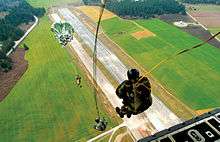Static line


A static line is a fixed cord attached to a large, stable object. It is used for safety in construction and to open parachutes automatically for paratroopers and novice parachutists.
Use in parachuting
In parachuting, a static line is a cord attached at one end to the aircraft and at the other end to the top of the jumper's 'D-Bag' (Deployment Bag, into which the canopy is packed). The parachutist's fall from the aircraft causes the static line to become taut, this then pulls the D-Bag out of the container on the jumper's back. The static line and D-Bag stay with the aircraft as the jumper leaves, and is pulled back into the aircraft by the dispatcher. Now free of its D-Bag, the canopy is allowed to inflate as the jumper continues to fall. Effectively, the jumper drags the parachute behind him, causing the upward-rushing wind to force open and inflate the canopy. The canopy should inflate and begin supporting the jumper within 4 seconds. In the unlikely event of a malfunction, students are taught how to cut away the main canopy and deploy the reserve chute. The aim of static line progression is to train students to maintain the correct, stable body position upon exiting the aircraft, and to teach how to deploy the canopy via the pilot chute mechanism.
As mentioned above the parachutist must adopt and maintain a stable body position throughout deployment to minimize the chances of a parachute malfunction. This method of parachute deployment is commonly used in several ways:
- Training student skydivers,[1] e.g. in the Ram Air Progression System
- BASE jumping
- Military paratroopers jumping from very low altitudes 400 ft (120 m)[2]
Static line jumping carries risk of injury[3] that, according to one study, doubles when performed in combat.[4]
For training students in civilian operations, modifications to existing static line equipment may be made to simplify operations. One such modification is to attach the deployment bag to the parachute instead of the static line, which also requires some modification to allow the static line to detach, typically a Velcro fastener. This leaves much less material "in the wind" behind the plane after the jumper has left. This isn't a problem for larger cargo aircraft used in military jumping, but presents a major issue for smaller aircraft used in civilian operations. This modification also results in a somewhat slower opening, which softens the opening shock at the cost of altitude, a minor concern for jumpers exiting at 2,800 ft (850 m).
Use in construction
In construction, a static line is a safety measure consisting of a cable race fixed to a roof at intervals to which a safety harness may be tethered.
See also
Accelerated freefall, an alternative method for training skydivers without using static line deployment.
References
- ↑ Poynter, Dan (1993). Parachuting Manual With Log for the Static Line Course. Para Publishing, ISBN 978-0-915516-84-1
- ↑ Craig SC, Lee T. Attention to detail: injuries at altitude among U.S. Army Military static line parachutists. Mil Med. 2000 Apr;165(4):268-71.
- ↑ Farrow GB. Military static line parachute injuries. Aust N Z J Surg. 1992 Mar;62(3):209-14.
External links
- What is Static Line Training? from DZsocial.com
- Static Line Monthly publication since 1947 for, by and about paratroopers, glidertroopers, air assault troopers.
- ArmyParatrooper.org Unofficial headquarters of military Paratroopers, past and present.
- The European Military Parachuting Association